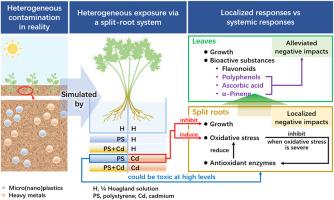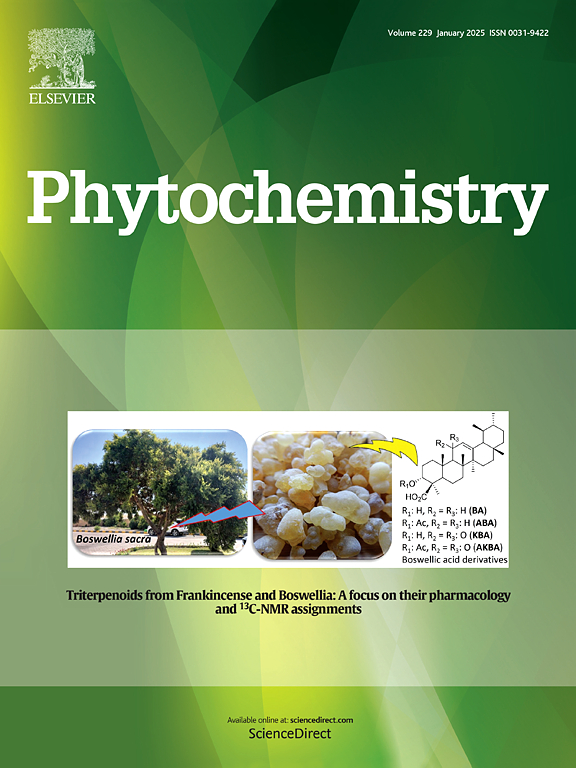Assessing heterogeneous pollution risks from polystyrene micro(nano)plastics and cadmium to physiology and biochemistry in parsley via a split-root system
IF 3.4
2区 生物学
Q2 BIOCHEMISTRY & MOLECULAR BIOLOGY
引用次数: 0
Abstract
The coexistence of micro(nano)plastics and heavy metals in agricultural ecosystems has garnered significant attention due to their complex threats to crop productivity and food safety. This study investigated the impacts of polystyrene (PS) micro(nano)plastics and cadmium (Cd) on the growth and biochemical characteristics of parsley, utilizing a split-root system to better capture the often-overlooked heterogeneous pollution patterns present in real agricultural environments. Localized responses were assessed through fresh weight and oxidative stress indicators including reactive oxygen species, antioxidant enzymes, and lipid peroxidation in split roots. Systemic responses were evaluated by fresh weight and bioactive substances including flavonoids, polyphenols, ascorbic acid (AsA), and α-pinene in leaves. Results for localized responses demonstrated that the growth inhibition and oxidative damage occurred in split roots under the coupled stresses were primarily driven by Cd. Notably, these effects were confined to the Cd exposure site, leaving the Cd-uncontaminated portion unharmed, highlighting the plant's self-protective mechanism to localize damage under heterogeneous pollution. Observations on systemic responses indicated that the leaf growth was not substantially hindered unless both sides of the split roots were exposed to Cd, which was attributed to the plant defense mechanism primarily activated by Cd and promoted by excessive PS nanoplastics. This mechanism particularly involved the antioxidant properties of non-flavonoid polyphenols, AsA, and α-pinene, exhibiting a multifaceted strategy employed by parsley to cope with complex contaminations. This work enhances our understanding of plant resilience in agricultural settings and offers insights for developing more nuanced agricultural practices.

通过分根系统评估聚苯乙烯微(纳米)塑料和镉对欧芹生理生化的异质性污染风险
微(纳)塑料和重金属在农业生态系统中的共存,因其对作物生产力和食品安全的复杂威胁而引起了人们的广泛关注。本研究研究了聚苯乙烯(PS)微(纳米)塑料和镉(Cd)对欧芹生长和生化特性的影响,利用分根系统更好地捕捉了现实农业环境中经常被忽视的异质性污染模式。通过劈裂根的鲜重和氧化应激指标(包括活性氧、抗氧化酶和脂质过氧化)来评估局部反应。以鲜重和叶片中黄酮类、多酚类、抗坏血酸(AsA)和α-蒎烯等生物活性物质评价系统反应。局部响应结果表明,耦合胁迫下裂根的生长抑制和氧化损伤主要是由Cd驱动的。值得注意的是,这些影响仅限于Cd暴露部位,未受Cd污染的部分没有受到伤害,这突出了植物在非均质污染下对损伤的自我保护机制。对系统反应的观察表明,除非裂根两侧暴露于Cd,否则叶片的生长不会受到实质性的阻碍,这可能是由于过量的PS纳米塑料促进了主要由Cd激活的植物防御机制。这一机制特别涉及非类黄酮多酚、AsA和α-蒎烯的抗氧化特性,显示了欧芹应对复杂污染的多方面策略。这项工作增强了我们对农业环境中植物恢复力的理解,并为开发更细致入微的农业实践提供了见解。
本文章由计算机程序翻译,如有差异,请以英文原文为准。
求助全文
约1分钟内获得全文
求助全文
来源期刊

Phytochemistry
生物-植物科学
CiteScore
6.40
自引率
7.90%
发文量
443
审稿时长
39 days
期刊介绍:
Phytochemistry is a leading international journal publishing studies of plant chemistry, biochemistry, molecular biology and genetics, structure and bioactivities of phytochemicals, including ''-omics'' and bioinformatics/computational biology approaches. Phytochemistry is a primary source for papers dealing with phytochemicals, especially reports concerning their biosynthesis, regulation, and biological properties both in planta and as bioactive principles. Articles are published online as soon as possible as Articles-in-Press and in 12 volumes per year. Occasional topic-focussed special issues are published composed of papers from invited authors.
 求助内容:
求助内容: 应助结果提醒方式:
应助结果提醒方式:


